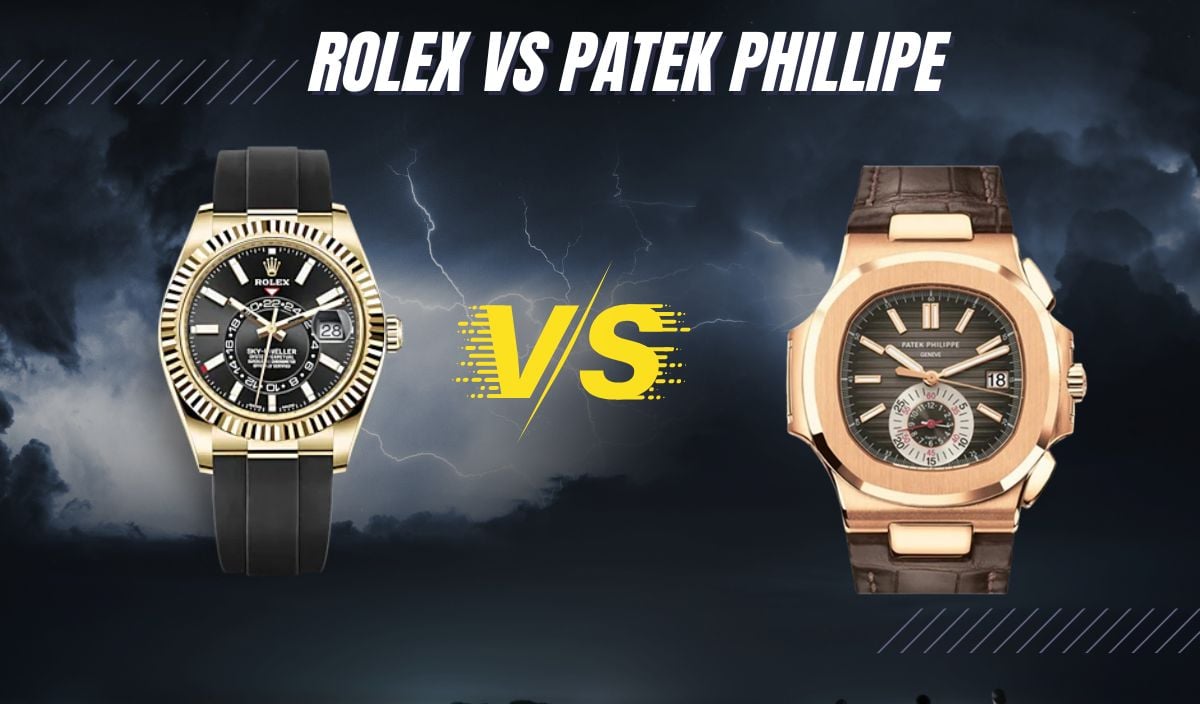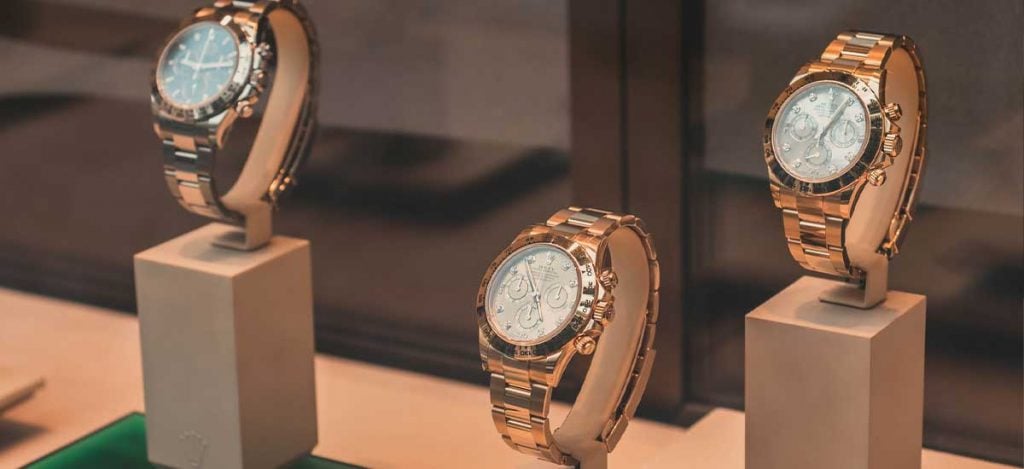
Both Rolex and Patek Philippe are incredibly iconic watchmakers known all throughout the world. These two companies are innovators and creators of their own original designs and have been leading the pack in the world of watchmaking.
Although these two are comparable, there are several big differences that make up each respective brand’s distinctive identity.
In this article, we will be looking at the similarities and differences between the two companies, and the pros and cons that come with each one. Though, there are more differences than similarities between the brands that we will discuss.
To begin this conversation, we have to talk about a sort of elephant in the room:
Why would you buy a Rolex over a Patek Philippe?

The main reason one might consider a Rolex watch over a Patek Philippe one comes down to a unique factor that this brand holds true over every single other watchmaker out there: popularity and recognition.
For many decades, Rolex has expertly marketed itself better than any other brand in the game and has become synonymous with concepts such as wealth, fashion, success, style, and more. The company has overall become the epitome of a “luxury wristwatch” to the general public. The golden standard.
Simply think, if you asked someone right now about Rolex, who is generally not in touch with knowledge regarding wristwatches, they will very likely be guaranteed to be familiar with the brand and those concepts stated earlier. It is a company that has remained in pop culture for decades similar to Apple, Nike, Coke, etc.
On the other hand, if you ask that same person about Patek Philippe, there is a slight chance that they might not know anything about their company; as Patek is targeted towards people of very high wealth, more so than Rolex, and their niche market are already aware of their existence, reputation, and offerings.
From this one very unique factor from Rolex, there come other unique advantages as well. One of these being that there will always be a very high demand for their watches from people all over the world. What this means for Rolex owners is that if you purchase one of their watches, you are almost certainly guaranteed to be able to resell that watch–likely for an even higher price than what you bought it for. This is one extremely appealing advantage to any sort of investor looking into the brand.
Pricing
Rolex vs Patek Philippe pricing is another big differentiating factor between the companies. As alluded to earlier, Rolex watches generally retail for much less than Patek Philippe’s offerings; and this could either be a good or bad thing depending on what kind of value you are seeking.
Patek Philippe watches of course hold their value and appreciate similarly to Rolex, but the number of people who are able to afford the high cost of a $100,000 Patek Philippe watch is diminished as opposed to the amount of people who won’t have to sell their car after buying a $10,000 Rolex. From this standpoint, it really does depend on an individual’s personal preferences and lifestyle.
To put this in perspective, at those prices listed earlier you could buy ten whole Rolex watches at the cost of that one Patek Philippe watch (if taxes didn’t exist).
To explore an example of this idea, let’s compare two of the most popular and iconic watches of each brand and ask a bit of a subjective question–Which is better, Rolex Submariner or Patek Philippe Aquanaut?
In this comparison, we find that the Submariner, as the name suggests, is designed for deep diving, having a high water resistance of 300m, and retails at around $10,000 – $40,000 usd. It is essentially built to withstand robust activities, has an outer timing bezel to time your dives or any other situation, and can be dressed up or down quite a bit.
The Patek Philippe Aquanaut on the other hand is also a type of “dive” watch withstanding 120m of water resistance, which is suitable for swimming but a bit riskier when diving,
Still, the Aquanaut is arguably more versatile than the Submariner. The reason for this is that it can be worn naturally with the highest end suit, but at the same time it can be rocked with jeans and a tee shirt. However this watch has a much wider range of price at approx. $30,000 – $130,000 usd.
So based on that, we once again find that this argument depends on an individual’s preferences and lifestyles. And speaking of lifestyles, that is another thing to consider when deciding between Rolex or Patek Philippe.
Types of Watches
Throughout the previous century, Rolex designed watches like the Submariner and their GMT to be robust and reliable in order to be used by personnel in the United States military. Doing so, they have created their catalog to consist of professional sport watches that have been tried and tested in true critical applications.
Additionally, their Explorer model was the primary watch provided by Rolex to be utilized by Edmund Hillary and Tenzing Norgay in their expedition to become the first people to ever climb the top of the tallest mountain on Earth, Mount Everest.
Today, these models are still in production, updated every year, and are in very high demand. Models like these can be easily worn every day for any situation at 100m – 300m of water resistance with shock resistant movements.
On the other side of the spectrum, Patek Philippe’s highest water resistance timepieces come at 120m, which is not bad either, for the very popular Nautilus and Aquanaut. Extremely versatile and beautiful watches that are swimmable but are not able to be worn without precaution in deep diving or in heavy water sports as stated before.
These two watches are actually more so comparable to the Rolex Explorer in all of those regards.
Another very popular watch known from Patek is their Perpetual Calendar. This beautiful timepiece is a staple when it comes to dress watches with complex movements. On the dial, it features a day, date, month, even a leap year indicator, and most iconically, its moonphase.
It is important to note that the moon phase design was first introduced by Patek Philippe themselves, and now lives on in this iconic model of theirs.
This leads our conversation into the opposite standpoint previously taken:
Why would you buy a Patek Philippe over a Rolex?

Although Patek does not offer any sort of 200m – 300m water resistant dive watch, as they are not primarily a tool watch kind of company, what they instill instead are some the highest end works of art–and that is how one should look at Patek Philippe as a whole.
When you think of it this way, those high prices are much more justified.
Think of a painting from a renowned artist. Now, that is simply colors being placed in specific areas of a canvas to make a work of art. Let’s say that painting sells for $100,000 like a Patek Philippe might. As a whole, the artist will likely have spent very little to create that art, as the real value comes from their name, talent, and work.
So although you might not know exactly who created your Patek Philippe watch, there is no denying that these are clearly artworks inside and out made by masters at their craft, consisting of precious metals, and house extremely advanced mechanical technologies inside the watches themselves.
What’s more, these ‘art pieces’ can of course be used in real life applications of primarily telling time, as part of an outfit or ensemble, and can carry the stories of the people who have worn them in the past.
It is also important to emphasize the incredible complexity in the watches that Patek Philippe make. They strive to really push the boundaries in terms of what is possible to function inside a watch, using only mechanical features.
They can go from a simple date-only complication in a Nautilus, to their Grandmaster Chime, which boasts twenty (yes, twenty) separate complications. Patek truly have no limits, and I doubt that they will stop at that twenty.
While both companies create their own in-house caliber movements, Rolex mostly focus on perfecting their original designs in order to provide the most efficient and reliable movements possible, while Patek focus more on creating those complex designs with many complications added onto it.
Nevertheless, we cannot forget to mention this simple powerful fact: Patek Philippe was the company that started it all and created the very first wristwatch in the late 1800s. That could be all the information you need if you are looking for the winner between these two companies.
Design
In terms of exterior design, Rolex has created some of the most recognizable layouts that have become blueprints for all other watches designed today–which could either be a pro or a con depending on how you look at it.
Let’s start with the most obvious: the Submariner. The design of this watch with its geometric circles, rectangles, and triangle indexes, as well as the outer bezel’s timing layout, have been a standard in dive watch design for its form and functionality.
There is not much that can be improved in this and that is why it has rarely changed since its inception, and continues to thrive today. However, like stated before, this could be a con for some people as these designs are very often similarly seen in many other companies.
Because the design has somewhat reached a peak in simplicity and functionality, many others will struggle to come up with anything different, which leaves many of the same-looking watches all over the place.
However, that is what does make Rolex so sought after–they are THE original. But again, although some companies have managed to slightly break the mold, it is extremely difficult to change what is not already broken.
Now moving on to Patek Philippe, their outer designs are generally much more unique to their respective brand. If you look around, you do not find many similar watch layouts like the Nautilus, Aquanaut, Perpetual Calendar, and especially not the Grandmaster Chime (I’d actually be shocked to see that). That can be a huge draw for someone looking for something very iconic, luxurious, but unique all at once.
Furthermore, Rolex cases and bracelets are very similar from model to model, such as their famous Oyster designs; whereas Patek Philippe seemingly strive to create differentiating and original cases for each one of their timepieces. So let’s summarize some of these points as they are commonly asked:
Frequently Asked Questions
Rolex has the unique advantage of popularity and recognition throughout the world; which Patek Philippe does as well, but Rolex is generally more known and accessible. Their average rough estimate price for one of their watches is somewhere around $15,000 usd, which is much less expensive than that of Patek Philippe’s.
Furthermore, Rolex has its rich history in professional sport watches, which they continue to manufacture today, and that is what primarily makes up their catalog if that is what you are looking for. Lastly, the value of their watches become investable, as they often appreciate over time.
Now, Patek Philippe can be quite a bit more expensive than Rolex depending on the model and make, but they must be thought of more as functional works of art than watches, really.
Moreover, their catalog consists of very unique designs that are not easily duplicated by other companies like the ones from Rolex are. Like stated before, Patek Philippe are some of the most expensive timepieces out there, but they are also the most reputable and recognized from best of the best when it comes to that arena
Another common debate being thrown around is that of Patek Philippe vs Rolex vs Omega. If we analyze these companies altogether, it is quickly evident that Patek Philippe is much more of a high end luxury and dressy brand, rather than a luxury sport watch one as both Rolex and Omega are.
Both Rolex and Omega have many more similarities than Patek Philippe in this regard, and they are real rivals when it comes to this.
Both have their own defining dive watches (Submariner vs Seamaster), ‘adventure’ type watches (Explorer vs Railmaster), chronographs (Daytona vs Speedmaster), and dress watches (Datejust vs Constellation)–just to name some of the more prominent categories. Both are also very highly marketed and recognized. Although Rolex definitely wins above all brands when it comes to that, Omega still holds its own against Rolex in that regard.
Nonetheless, their true differences lie in their price ranges, as Omega is a sort of entry-level in the world of luxury sport watches, ranging anywhere between approx. $3,000 – $15,000 usd. Whereas Rolex can range a bit higher in price as previously discussed. So this debate mostly depends on an individual’s preference in brand and their budget
Interestingly, both companies likely average around the same time of accuracy. This is due to Patek’s incredibly complex movements with many different complications, and more complications mean more things that can vary an accuracy.
Meanwhile, Rolex have mostly focused on perfecting their movements with maybe one or two simple complications. After decades of testing, and thousands of people wearing their watches, Rolex have come a very long way in terms of functionality in their movements. And in doing so, they compete with Patek Philippe in the topic of accuracy.
Patek Philippe was founded in 1839, and Rolex in 1905. As previously discussed, Patek Philippe was also the company that first introduced the world to watches, but Rolex still has a lot of “firsts.”
For instance, they created the famous GMT movement for United States aviators in the 50s, which became one of their crowning (no pun intended) achievements. Patek, however, invented other features now commonly known such as the moon phase complication; which they still use in the Perpetual Calendar as one of their main lineups.
Conclusion
In summary, both Rolex and Patek Philippe are giants in the watchmaking industry. They pioneered many of the designs we see today, but they are not all that similar to one another overall. Rolex built their reputation based on creating professional sport watches to be tested in real life situations, and at the same time marketed those watches towards the average citizen.
Whereas, Patek Philippe built their own brand based on perfecting the concept of a mechanical wristwatch, and pushing the boundaries in terms of materials, movements, complications, and designs overall.
Rolex is more affordable than Patek Philippe, but both are creators with distinct identities, rich histories, and iconic catalogs to choose from. So as stated before, choosing between these two comes down to an individual’s personal preferences, how they live their life, their budget, and the kind of value they seek. Or just get both, why not?







